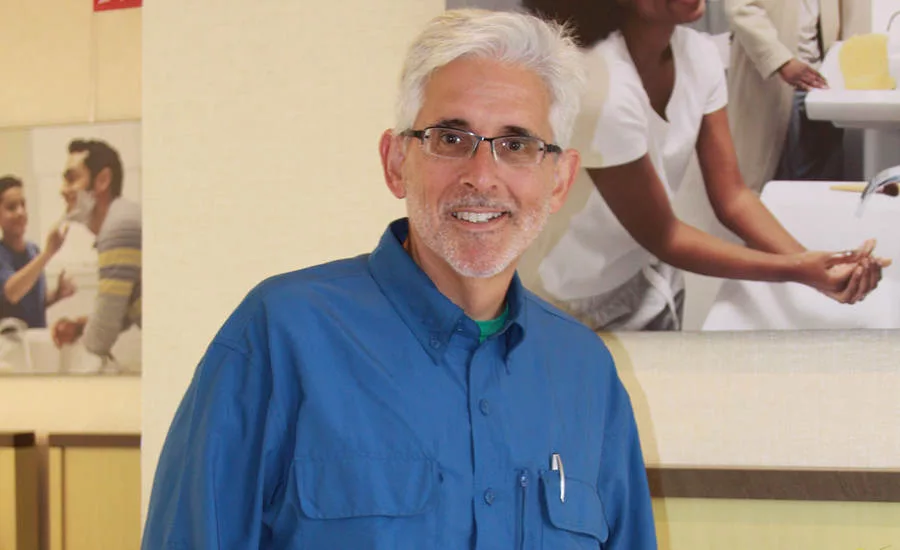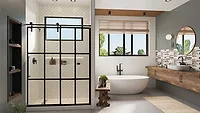PM Profile: LIXIL Americas' Gray Uhl

Gray Uhl is brand education director at LIXIL Americas.
In 1988, American Standard began manufacturing its Americast line of bathtubs in Salem, Ohio. Nearly 30 years later, the line is still manufactured exclusively at the Midwestern facility, though improvements have been made to the product line over the years.
Recently, PM interviewed Gray Uhl, brand education director at LIXIL Americas, who talked about some of those improvements and hinted at what may be coming soon from Americast.
PM: What sets Americast bathtubs apart?
GU: Decades ago, American Standard had been the largest producer of cast iron products for the bathroom, but there were some things that were challenging about the design. Right off the bat? Weight. So American Standard decided in the 1980s to come up with a really high-tech replacement for cast iron — a more modern, really contemporary product using materials out of the automotive and aerospace industry.
We decided to make a better product than we were able to make in cast iron. Cast iron is very heavy, and when you put hot water in the cast iron, it loses heat — it sucks the heat out of the hot water. We have heard stories of people who would fill a tub with hot water, drain it and then put the hot water back into the bath.
Another challenge was in the process for casting iron bathtubs. When it was being fired, the shape was not stable, it was not accurate. So that became a challenge for the plumber, who had to cut tile and shim and do all these things to install it.
So we wanted to come up with a product that was contemporary, using contemporary materials, that still had a really durable surface — especially for hotels so they could scrub it every day and it would hold up to really tough use. We wanted the same durable, black, porcelain-enameled finish, which is actually ground-up glass that you put it on the product, and in the oven, the glass melts and flows and makes a really tough, durable surface. And so Americast really did all that.
Americast has a composite structure. It is a formed metal. There’s the white layer on top — that’s the actual porcelain enamel. Right below that is a gray primer layer of porcelain enamel. And then there’s a metal layer — that’s the actual tub. Then the backside is a solid surface material — that is the structural part of Americast. So when it comes out of the mold, it has all the rigidity of cast iron and does not flex at all.
It’s dimensionally all correct because it is formed inside a very precise mold, so it isn’t warped or twisted in any way. That backing is insulating and has thermal properties. It keeps all the heat in the tub and also has great sound quality. If you’ve ever been in a steel tub, it’s like if you knock on it, it’s like bathing in a tin can. In this case, you can see that the material is very rigid.
PM: What are some of the ways in which Americast keeps the plumber in mind?
GU: So, depending on which model, Americast bathtubs are between one-third and one-half the weight of a cast iron tub. It’s dramatically less. And how that impacts the plumber is that, very often, one plumber can carry an Americast tub into the house and up the stairs, and one plumber can install it. With a cast iron tub, you’re going to have to have two plumbers. It’s also dimensionally stable, but the weight — the notion that I can flip it up sideways and I can carry it in through a bathroom door, it’s just a lot easier.
We make a version where, because we mold this, the drain and overflow are molded into it — it’s already in place. So when the plumber pulls the tub out of the box, the drain and overflow are molded in at the factory, so there are no joints or seams. When the plumber pulls it out of the box, it’s ready to go. He does not have to have purchased or assembled a drain. So not only is it quicker and easier for the plumber, it eliminates any potential leaks at all those joints in the drain assembly. And that, again, you can only do with Americast.
PM: What are some of the most common applications for the Americast line?
GU: It is very popular in hospitality. You can imagine hotel rooms — it’s a product that stands up to the cleaning crew cleaning it every day. So it’s very popular commercially, very popular in hospitality.
On the residential side, we make a very deep version of Americast that can be used in the master bath, but most of them that we sell end up in the family bathroom that is shared by multiple people. Adults use it as a shower and we designed it so that the step-over height is not dramatic. It’s easy to get in and out of as a shower, but it’s an excellent shape and depth for bathing kids.
So, it’s a great family transitional tub from kids who go from bathing as they grow to showering. And I would say, the majority of the time, residentially, that is where the Americast ends up being installed. We do make a small percentage of luxury tubs, and we even offer it as a whirlpool.
PM: Do you notice any big differences between American and European bathtub trends?
GU: I don’t really see any influence from Europe when it comes to bathing. I really don’t. Certainly the trends in the U.S., at the moment, is moving toward free-standing tubs. The population, in general, is taking more showers than bathing, and that’s one of the advantages of the Princeton Americast tub — which we sell the most of. It is engineered to work both as a bathtub and as a shower. The step-over height is reasonable, doable for most adults.
I would say, if there’s any trend globally, it’s more showers. Even the Europeans are taking more showers than they are bathing, according to the numbers. In my opinion, European bathroom trends do not have much of an influence in America. Americans are pretty particular, and they expect a lot from their tubs. For example, in Europe, they tend to have more steel tubs, and they have a higher step-over height to get in and out. These are not things Americans find appealing.
PM: How is your manufacturing facility or the Americast product itself “green”?
GU: There are two things I think we are doing that relate to the environment. One is the longevity of the product — it has a very, very long life because it is so durable. The notion of a plastic or acrylic tub wearing out, they may not have as long of a life span or the durability as this.
The second thing from an environmental perspective is that it takes less energy to make an Americast tub than the energy it takes to make a cast iron tub. And in the process, anything that is cut or trimmed is collected and recycled, and the porcelain enamel, when it’s sprayed on, the excess gets collected and recycled.
PM: What is the future of Americast?
GU: American Standard, as part of LIXIL, is a very dynamic company, and we’re doing really amazing things. I’ve been here 28 years now, and it is the most exciting time in my career.
We have just, within the last year, improved the non-skid pattern on the bottom. It used to be in a decorative pattern, but we’ve now made the entire bottom a non-skid surface. We’ve also reformulated it so it has all the safety benefits but stays cleaner longer and is easier to clean. You can imagine a porcelain surface has a little texture to it, and that texture can grab or collect dirt, but we have reformulated that. If you look at it on a microscopic level, there are fewer peaks and valleys to hold the dirt, but it still has the same grip on your skin — the same coefficient of drag. That is an improvement we just made.
And, certainly, the future of Americast is that we are looking at doing new shapes. In the near future, you will see some newer designs. The designs we have today are very transitional, so they are purposely designed to fit in any scenario, whether someone is building a hotel or a home, either very traditional or very contemporary or eclectic, the design is very transitional. But we are looking, in the very near future, to work on some new shapes. Our manufacturing process allows us to do that.
Looking for a reprint of this article?
From high-res PDFs to custom plaques, order your copy today!







